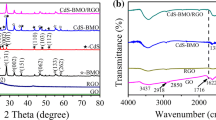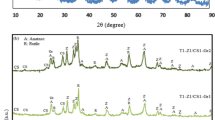Abstract
Pharmaceutical wastewater treatment is an essential component of environmental protection and sustainable development. In this study, our aim was to investigate the morphology, characterization, and effectiveness of TiO2/graphene composite nanofiber photocatalysts in the treatment of pharmaceutical wastewater containing three different pharmaceutical groups, such as an antibiotic (rifampin), painkiller (phenazopyridine), and immunosuppressant (azathioprine). Various parameters such as pH, salt concentration, and initial pharmaceutical compound concentration were optimized to achieve maximum degradation kinetics and efficiency. The optimum conditions were determined to be 1.5% graphene content, 30 ppm initial concentration of pharmaceutical compound, pH=5, and a 0.5 g/L photocatalyst dose. The presence of salt slightly decreased the degradation kinetics, but it did not significantly affect the performance of the TiO2/graphene composite nanofibers photocatalyst. At optimum condition, TiO2/1.5% graphene composite nanofibers degraded 50% of phenazopyridine, 86.89% of rifampin, and completely azathioprine. Comparing with phenazopyridine, N heteroatom-rich molecule of azathioprine and hydroxyl-rich molecule of rifampin lead to being susceptible to photocatalytic degradation. The reuse of the photocatalyst in multiple cycles showed consistent performance, indicating its potential for practical and economic applications.
Graphical Abstract
















Similar content being viewed by others
Data availability
The experimental data and results that support the findings of this study are available within the paper.
References
Ansaripoor-Jermafshadi Z, Nezamzadeh-Ejhieh A (2022) The experimental design and mechanism study of the rifampin photodegradation by PbS-Co3O4 coupled catalyst. Mater Res Bull 155:111972. https://doi.org/10.1016/j.materresbull.2022.111972
Bayan EM, Pustovaya LE, Volkova MG (2021) Recent advances in TiO2-based materials for photocatalytic degradation of antibiotics in aqueous systems. Environ Technol Innov 24:101822. https://doi.org/10.1016/j.eti.2021.101822
Biris AR, Toloman D, Popa A et al (2016) Synthesis of tunable core-shell nanostructures based on TiO2-graphene architectures and their application in the photodegradation of rhodamine dyes. Phys E Low-Dimensional Syst Nanostruct 81:326–333. https://doi.org/10.1016/j.physe.2016.03.028
Boyer SM, Liu J, Zhang S et al (2016) The role of ruthenium photosensitizers in the degradation of phenazopyridine with TiO2 electrospun fibers. J Photochem Photobiol A Chem 329:46–53. https://doi.org/10.1016/j.jphotochem.2016.06.007
Brito LRD, Ganiyu SO, dos Santos EV et al (2021) Removal of antibiotic rifampicin from aqueous media by advanced electrochemical oxidation: Role of electrode materials, electrolytes and real water matrices. Electrochim Acta 396:139254. https://doi.org/10.1016/j.electacta.2021.139254
Cristino V, Longobucco G, Marchetti N et al (2020) Photoelectrochemical degradation of pharmaceuticals at β25 modified WO3 interfaces. Catal Today 340:302–310. https://doi.org/10.1016/j.cattod.2018.09.020
Eskandarloo H, Badiei A, Behnajady MA (2015) Application of response surface methodology for optimization of operational variables in photodegradation of phenazopyridine drug using TiO 2 /CeO 2 hybrid nanoparticles. Desalin Water Treat 54:3300–3310. https://doi.org/10.1080/19443994.2014.911705
Faraldos M, Bahamonde A (2017) Environmental applications of titania-graphene photocatalysts. Catal Today 285:13–28. https://doi.org/10.1016/j.cattod.2017.01.029
Fathinia M, Khataee A (2015) Photocatalytic ozonation of phenazopyridine using TiO2 nanoparticles coated on ceramic plates: mechanistic studies, degradation intermediates and ecotoxicological assessments. Appl Catal A Gen 491:136–154. https://doi.org/10.1016/j.apcata.2014.10.049
Fathinia M, Khataee A, Aber S, Naseri A (2016) Development of kinetic models for photocatalytic ozonation of phenazopyridine on TiO2 nanoparticles thin film in a mixed semi-batch photoreactor. Appl Catal B Environ 184:270–284. https://doi.org/10.1016/j.apcatb.2015.11.033
Fathinia M, Khataee AR, Zarei M, Aber S (2010) Comparative photocatalytic degradation of two dyes on immobilized TiO 2 nanoparticles: Effect of dye molecular structure and response surface approach. J Mol Catal A Chem 333:73–84. https://doi.org/10.1016/j.molcata.2010.09.018
Gao B, Dong S, Liu J et al (2016) Identification of intermediates and transformation pathways derived from photocatalytic degradation of five antibiotics on ZnIn2S4. Chem Eng J 304:826–840. https://doi.org/10.1016/j.cej.2016.07.029
Gao Y, Yan N, Jiang C et al (2020) Filtration-enhanced highly efficient photocatalytic degradation with a novel electrospun rGO@TiO2 nanofibrous membrane: implication for improving photocatalytic efficiency. Appl Catal B Environ 268:118737. https://doi.org/10.1016/j.apcatb.2020.118737
Gholizadeh AM, Zarei M, Ebratkhahan M, Hasanzadeh A (2021) Phenazopyridine degradation by electro-Fenton process with magnetite nanoparticles-activated carbon cathode, artificial neural networks modeling. J Environ Chem Eng 9:104999. https://doi.org/10.1016/j.jece.2020.104999
Houas A, Lachheb H, Ksibi M et al (2001) Photocatalytic degradation pathway of methylene blue in water. Appl Catal B Environ 31:145–157. https://doi.org/10.1016/S0926-3373(00)00276-9
Howes BD, Guerrini L, Sanchez-Cortes S et al (2007) The influence of pH and anions on the adsorption mechanism of rifampicin on silver colloids. J Raman Spectrosc 38:859–864. https://doi.org/10.1002/jrs.1727
Huang X, Yang W, Zhang G et al (2021) Alternative synthesis of nitrogen and carbon co-doped TiO2 for removing fluoroquinolone antibiotics in water under visible light. Catal Today 361:11–16. https://doi.org/10.1016/j.cattod.2019.10.034
Khataee AR, Pons MN, Zahraa O (2009) Photocatalytic degradation of three azo dyes using immobilized TiO2 nanoparticles on glass plates activated by UV light irradiation: Influence of dye molecular structure. J Hazard Mater 168:451–457. https://doi.org/10.1016/j.jhazmat.2009.02.052
Koe WS, Lee JW, Chong WC et al (2020) An overview of photocatalytic degradation: photocatalysts, mechanisms, and development of photocatalytic membrane. Environ Sci Pollut Res 27:2522–2565. https://doi.org/10.1007/s11356-019-07193-5
Laera G, Jin B, Zhu H, Lopez A (2011) Photocatalytic activity of TiO2 nanofibers in simulated and real municipal effluents. Catal Today 161:147–152. https://doi.org/10.1016/j.cattod.2010.10.037
Lakshmi CS, Reddy MN (1998) Spectrophotometric determination of azathioprine in pharmaceutical formulations. Talanta 47:1279–1286. https://doi.org/10.1016/S0039-9140(98)00216-1
Lavanya T, Dutta M, Ramaprabhu S, Satheesh K (2017) Superior photocatalytic performance of graphene wrapped anatase/rutile mixed phase TiO2 nanofibers synthesized by a simple and facile route. J Environ Chem Eng 5:494–503. https://doi.org/10.1016/j.jece.2016.12.025
Li Y, Sun S, Ma M et al (2008) Kinetic study and model of the photocatalytic degradation of rhodamine B (RhB) by a TiO2-coated activated carbon catalyst: Effects of initial RhB content, light intensity and TiO2 content in the catalyst. Chem Eng J 142:147–155. https://doi.org/10.1016/j.cej.2008.01.009
Lin Z, Weng X, Owens G, Chen Z (2020) Simultaneous removal of Pb(II) and rifampicin from wastewater by iron nanoparticles synthesized by a tea extract. J Clean Prod 242:1–9. https://doi.org/10.1016/j.jclepro.2019.118476
Liu F, Wang M, Chen Y, Gao J (2019) Thermal stability of graphene in inert atmosphere at high temperature. J Solid State Chem 276:100–103. https://doi.org/10.1016/j.jssc.2019.04.008
Liu J, McCarthy DL, Cowan MJ et al (2016) Photocatalytic activity of TiO2 polycrystalline sub-micron fibers with variable rutile fraction. Appl Catal B Environ 187:154–162. https://doi.org/10.1016/j.apcatb.2015.12.040
Liu L, Xu Q, Owens G, Chen Z (2021) Fenton-oxidation of rifampicin via a green synthesized rGO@nFe/Pd nanocomposite. J Hazard Mater 402:123544. https://doi.org/10.1016/j.jhazmat.2020.123544
Madivoli ES, Kareru PG, Makhanu DS et al (2020) Synthesis of spherical titanium dioxide microspheres and its application to degrade rifampicin. Environ Nanotechnol Monit Manag 14:100327. https://doi.org/10.1016/j.enmm.2020.100327
Meijide J, Lama G, Pazos M et al (2022) Ultraviolet-based heterogeneous advanced oxidation processes as technologies to remove pharmaceuticals from wastewater: an overview. J Environ Chem Eng 10:107630. https://doi.org/10.1016/j.jece.2022.107630
Mohamed RM, McKinney DL, Sigmund WM (2012) Enhanced nanocatalysts. Mater Sci Eng R Reports 73:1–13. https://doi.org/10.1016/j.mser.2011.09.001
Molinari R, Pirillo F, Loddo V, Palmisano L (2006) Heterogeneous photocatalytic degradation of pharmaceuticals in water by using polycrystalline TiO2 and a nanofiltration membrane reactor. Catal Today 118:205–213. https://doi.org/10.1016/j.cattod.2005.11.091
Oad NP, Chandra P, Mohammad A et al (2023) MoS2-based hetero-nanostructures for photocatalytic, photoelectrocatalytic and piezocatalytic remediation of hazardous pharmaceuticals. J Environ Chem Eng 11:109604. https://doi.org/10.1016/j.jece.2023.109604
Pan X, Zhao Y, Liu S et al (2012) Comparing graphene-TiO2 nanowire and graphene-TiO2 nanoparticle composite photocatalysts. ACS Appl Mater Interfaces 4:3944–3950. https://doi.org/10.1021/am300772t
Pasini SM, Valério A, Yin G et al (2021) An overview on nanostructured TiO2–containing fibers for photocatalytic degradation of organic pollutants in wastewater treatment. J Water Process Eng 40:101827. https://doi.org/10.1016/j.jwpe.2020.101827
Pelalak R, Heidari Z, Forouzesh M et al (2021) High performance ozone based advanced oxidation processes catalyzed with novel argon plasma treated iron oxyhydroxide hydrate for phenazopyridine degradation. Sci Rep 11:1–18. https://doi.org/10.1038/s41598-020-80200-9
Ramasundaram S, Yoo HN, Song KG et al (2013) Titanium dioxide nanofibers integrated stainless steel filter for photocatalytic degradation of pharmaceutical compounds. J Hazard Mater 258–259:124–132. https://doi.org/10.1016/j.jhazmat.2013.04.047
Reza KM, Kurny A, Gulshan F (2017) Parameters affecting the photocatalytic degradation of dyes using TiO2: a review. Appl Water Sci 7:1569–1578. https://doi.org/10.1007/s13201-015-0367-y
Sabouni R, Gomaa H (2019) Photocatalytic degradation of pharmaceutical micro-pollutants using ZnO. Environ Sci Pollut Res 26:5372–5380. https://doi.org/10.1007/s11356-018-4051-2
Secundino-Sánchez O, Díaz-Reyes J, Sánchez-Ramírez JF et al (2022) Controlled synthesis of electrospun TiO2 nanofibers and their photocatalytic application in the decolouration of Remazol Black B azo dye. Catal Today 392–393:13–22. https://doi.org/10.1016/j.cattod.2021.10.003
Valente JPS, Padilha PM, Florentino AO (2006) Studies on the adsorption and kinetics of photodegradation of a model compound for heterogeneous photocatalysis onto TiO2. Chemosphere 64:1128–1133. https://doi.org/10.1016/j.chemosphere.2005.11.050
Vinu R, Akki SU, Madras G (2010) Investigation of dye functional group on the photocatalytic degradation of dyes by nano-TiO2. J Hazard Mater 176:765–773. https://doi.org/10.1016/j.jhazmat.2009.11.101
Yang Y, Xu L, Wang H et al (2016) TiO2/graphene porous composite and its photocatalytic degradation of methylene blue. Mater Des 108:632–639. https://doi.org/10.1016/j.matdes.2016.06.104
Yurdakal S, Loddo V, Augugliaro V et al (2007) Photodegradation of pharmaceutical drugs in aqueous TiO2 suspensions: mechanism and kinetics. Catal Today 129:9–15. https://doi.org/10.1016/j.cattod.2007.06.044
Zhang N, Li B, Li S, Yang S (2017) Graphene-supported mesoporous titania nanosheets for efficient photodegradation. J Colloid Interface Sci 505:711–718. https://doi.org/10.1016/j.jcis.2017.06.063
Zhang Y, Zhang J, Xiao Y et al (2016) Kinetic and mechanistic investigation of azathioprine degradation in water by UV, UV / H 2 O 2 and UV / persulfate. Chem Eng J 302:526–534. https://doi.org/10.1016/j.cej.2016.05.085
Zyoud AH, Zaatar N, Saadeddin I et al (2010) CdS-sensitized TiO2 in phenazopyridine photo-degradation: catalyst efficiency, stability and feasibility assessment. J Hazard Mater 173:318–325. https://doi.org/10.1016/j.jhazmat.2009.08.093
Author information
Authors and Affiliations
Contributions
All authors contributed to the study conception and design. Material preparation, data collection and analysis, and preparation of first draft were performed by Masoumeh Sharif Teshnizi. Conceptualization, funding acquisition, project administration, supervision, review, and editing were performed by Mohammad Karimi. All authors read and approved the final manuscript.
Corresponding author
Ethics declarations
Ethics approval
We confirmed that the current work is an original for the authors and has not published or under review in any journal.
Consent to participate
Not applicable.
Consent for publication
Not applicable.
Competing interests
The authors declare no competing interests.
Additional information
Responsible Editor: George Z. Kyzas
Publisher's Note
Springer Nature remains neutral with regard to jurisdictional claims in published maps and institutional affiliations.
Rights and permissions
Springer Nature or its licensor (e.g. a society or other partner) holds exclusive rights to this article under a publishing agreement with the author(s) or other rightsholder(s); author self-archiving of the accepted manuscript version of this article is solely governed by the terms of such publishing agreement and applicable law.
About this article
Cite this article
Sharifi Teshnizi, M., Karimi, M. TiO2/graphene composite nanofibers for efficient photocatalytic degradation of pharmaceutical compounds: Rifampin, Phenazopyridine, Azathioprine. Environ Sci Pollut Res 30, 107956–107969 (2023). https://doi.org/10.1007/s11356-023-29869-9
Received:
Accepted:
Published:
Issue Date:
DOI: https://doi.org/10.1007/s11356-023-29869-9




